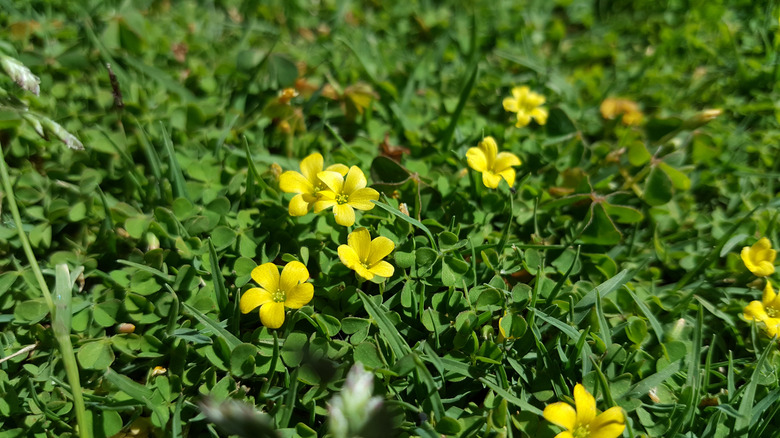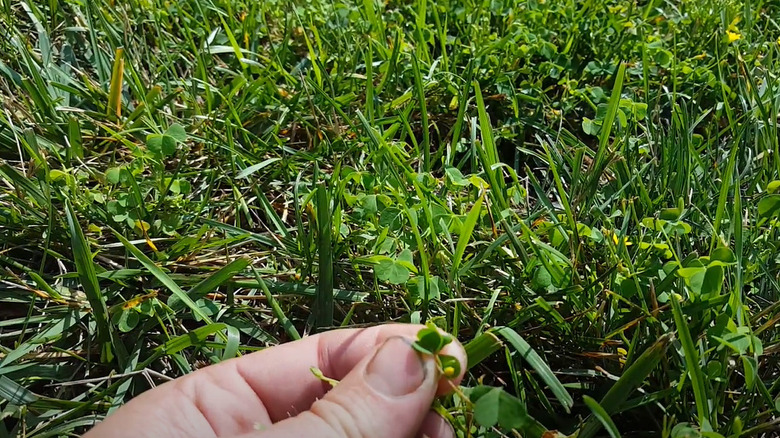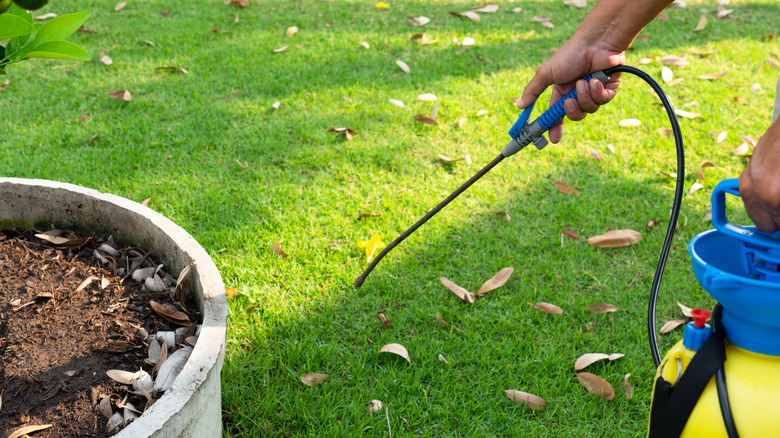How To Control Woodsorrel In Your Lawn
We may receive a commission on purchases made from links.
The sight of yellow blooms peeping through your lush green lawn may seem charming, but what if you discover these aren't just everyday flowers but woodsorrel weeds? This tiny troublemaker of your green sanctuary, a member of the Oxalis family, is as treacherous as a cloak-and-dagger spy, masquerading as the friendly clover. But unlike the almost round leaves of a clover, oxalis sports heart-shaped leaves and cheers on spring and early summer with bright yellow flowers. And guess what? They party hard, propagating by both seeds and rhizomes. Moreover, woodsorrel's seeds are seemingly "spring-loaded" and can be catapulted as far as 13 feet when the capsules rupture.
Allowing these lawn weeds to sprout is the starting point where your lawn's story takes a grim turn. Once they have made themselves at home, oxalis plants can be highly assertive and overrun your lawn in no time. The big question then arises: How do you get rid of woodsorrel in grass? Well, this can take a physical or chemical route. One of the physical weed control methods for oxalis is hand-pulling, which might seem like a mammoth task considering the weed's rapid spread. As ideas of a chemical approach begin to swirl, you might be wondering, "What will kill oxalis but not grass?" Well, several herbicide formulations can launch a pre-emptive strike or clean up the scene post-infestation, all without harming your grass.
Physical weed control of woodsorrel in lawns
Let's begin with hand-pulling oxalis. The rule of thumb is to strike while the irons (or, in this case, the oxalis) are hot — before they bloom or disperse seeds. Any remnants can regenerate into a tenacious invasion. So, make no compromises; every trace of their extensive root system must be eliminated. Battle conditions, too, matter for effective weed pulling; strike when the soil is damp. Alternatively, employ a tool like Ames Stand-Up Weeder from The Home Depot. With a commendable 4.1/5 rating from 1000+ reviews, this tool has charmed many gardening warriors.
The buttercup oxalis is a bit cunning to eradicate, thanks to its bulbous reproduction. So, don't be fooled into merely cutting off its top; that will leave the enemy's root unscathed. Instead, disarm it directly from the bulb. While it's necessary to dispose of the uprooted plants responsibly, keep those with seeds away from compost bins to prevent an invasion sequel.
Now, onto safeguarding your lawn against woodsorrel. It's typical lawn care advice you could be overlooking: Fuel grass growth with nutrients that boost vibrancy and thickness. Moderate, deep watering will promote strong root development, making your lawn a formidable fortress against oxalis invasion. Lastly, always set your mowing height right. With zoysia or centipede grass varieties, keep it at 2 to 3 inches. Bermuda prefers it slightly more daring at 1.5 to 2 inches. Fescues, perennial ryegrass, or Kentucky bluegrass demand a luxurious 3 to 4 inches.
Best herbicides for lawn woodsorrel
In the chemical war battle against oxalis, you don't want to wipe all vegetation but selectively target the villain in question. Start with a pre-emergent herbicide, timing the attack to align with woodsorrel's seed germination period. Look for ingredients like dithiopyr, isoxaben, oryzalin, or prodiamine. An excellent recommendation would be The Andersons' prodiamine-laced Barricade Granular Pre-Emergent Herbicide on Amazon, boasting an impressive 4.5/5 score from over 3,800 reviews. Watering your lawn (ideally, three to five days post-application) activates a pre-emergent herbicide's lethality, with granular versions craving more water than their liquid counterparts.
In the unfortunate event of you missing the germination window or facing sprouted woodsorrel, post-emergent herbicides can help. These boast more potent ingredients, such as atrazine, 2,4-D, dicamba, mecoprop (MCCP), triclopyr, and sulfentrazone. Trimec Weed Herbicide Concentrate from Amazon is a worthy option here. Its triple-action formula combining 2,4-D, dicamba, and mecoprop (MCCP) adds to its potency, applauded by some customers for its efficacy against stubborn broadleaf weeds. But remember, post-emergents show their might best against young weeds.
Now, onto picking the best herbicide application technique. Spot treatment, where you target individual weeds, is your best bet for minor infestations. For a thriving woodsorrel population, broadcast spraying comes into play, providing comprehensive coverage. Caution: Always aim for the Goldilocks Zone of the weather (not too hot nor too cold), irrigate before use to ward off heat stress, and pick a non-windy day to keep the herbicide mist from straying afar.


